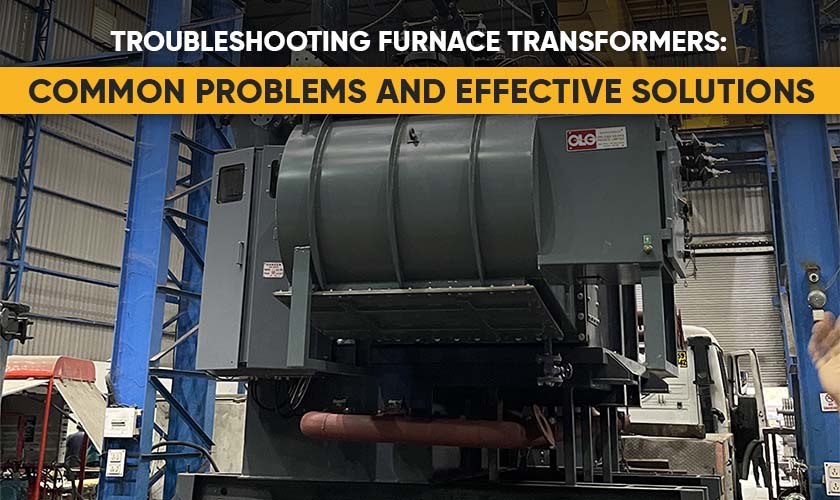When it comes to furnace operations, transformers play a key role in making sure everything runs smoothly, safely, and efficiently. But there’s one silent player in the performance of furnace transformers that often goes unnoticed: the power factor.
Power factor may sound like something straight out of a physics textbook, but its impact on furnace transformer performance is very real. If ignored, it can lead to overheating, increased energy bills, and unexpected downtime. If understood and optimized, it can unlock better efficiency, lower costs, and a longer lifespan for your transformer.
In this blog, we break down what power factor is, how it affects furnace transformer performance, and why monitoring it is essential. As specialists in industrial transformers, we at Makpower Transformer know the importance of educating our customers on power factor to ensure the longevity and efficiency of their equipment.
What is Power Factor?
Let’s start with the basics. Power factor is the ratio between real power (measured in kilowatts or kW) and apparent power (measured in kilovolt-amperes or kVA). It tells you how efficiently electrical power is being used.
Here’s a simple analogy:
Imagine you’re drinking a glass of soda with ice. The soda is your real power, the usable part. The ice, though still part of the glass’s contents, doesn’t quench your thirst. That’s your reactive power. The total volume of the glass (soda + ice) is the apparent power.
So, a power factor of 1 (or 100%) means all the power is being used effectively, just soda, no ice. A power factor of 0.7 means only 70% is usable, while the rest is reactive ice, taking up space.
In most industrial setups, including those using furnace transformers, the power factor is rarely perfect. But the closer it is to 1, the better.
Why Furnace Transformers Need a Good Power Factor
Furnace transformers are workhorses. They deal with fluctuating loads, high temperatures, and extreme conditions. The better the power factor, the easier it is for the transformer to do its job without straining.
Here’s how a low power factor can hurt furnace transformer performance:
1. Increased Current Draw
A low power factor means more current is required to deliver the same amount of useful power. This puts extra stress on your transformer. Increased current leads to:
- Higher copper losses (I²R losses)
- Overheating.
- Reduced transformer life.
We at Makpower Transformer design our furnace transformers to withstand demanding environments, but a poor power factor will always reduce operational efficiency over time.
2. Overloading and Capacity Issues
Because the transformer must handle more current at a low power factor, it might reach its rated capacity faster, even if your furnace isn’t drawing its full power potential. This limits your system’s ability to expand or operate at higher loads.
In other words, you're not making the most of your transformer investment.
3. Voltage Drops
Higher currents also cause greater voltage drops across the system. This affects furnace performance, potentially causing unstable temperatures, poor material quality, and slower processing times.
Imagine trying to bake a cake in an oven that keeps fluctuating between 150°C and 220°C. Not ideal, right? That’s what a furnace faces under poor voltage conditions.
4. Higher Electricity Costs
Utilities often penalize customers with a low power factor. These penalties show up as extra charges on your energy bill. Over time, these can become significant, costing your business thousands.
By improving your power factor, you reduce energy waste and save money in the long run. We help our customers integrate solutions that optimize power factor, reduce costs, and improve system reliability.
How Power Factor Correction Helps
Power factor correction (PFC) is the process of improving the power factor to get closer to 1. This is usually done by installing capacitor banks, synchronous condensers, or active filters in the system.
Benefits of Power Factor Correction in Furnace Systems:
- Reduces transformer load: Less current is needed for the same power.
- Improves system voltage: Leads to better furnace performance.
- Enhances efficiency: Less energy is wasted in heat or losses.
- Lowers electricity bills: Reduced demand charges from utility companies.
- Increases transformer lifespan: Less wear and tear on your system.
At Makpower Transformer, we not only manufacture high-performance furnace transformers but also help our clients with complete power system analysis and recommendations. We believe that transformer performance isn’t just about the product; it’s about how the entire system works together.
How We Design Transformers With Power Factor in Mind
At Makpower, we understand that not every client has a perfect power factor. That’s why our furnace transformers are designed to handle fluctuating loads, non-linear demand, and harsh industrial environments.
Some key features we offer:
- High overload capacity for short bursts during poor power factor events.
- Thermal monitoring and safety systems to prevent damage due to overheating.
- Custom winding configurations for optimal performance with furnace applications.
- Flexible design to suit arc furnaces, induction furnaces, and other high-reactive load equipment.
When you work with us, you’re not just getting a transformer. You’re getting a partner that understands the ins and outs of industrial power systems and knows how to make them better.
Monitoring and Maintenance: Keep Your Power Factor in Check
Even with the best transformer and a good power factor, regular monitoring is key. Power systems evolve, loads change, and new equipment is added. Over time, the power factor may degrade.
Here are a few tips:
- Install power quality meters to track PF in real time.
- Review utility bills to check for PF penalties.
- Schedule regular transformer maintenance to catch early signs of stress or overheating.
- Consult with experts to evaluate your load profile and PF status.
At Makpower, we also offer transformer servicing and audits to ensure your system is running at peak performance.
Final Thoughts
If you’re investing in furnace transformers, it’s not just about voltage and current ratings. Understanding and optimizing your power factor is one of the smartest things you can do for your system.
A good power factor means:
- More efficient transformer operation
- Fewer overheating issues
- Better furnace performance
- Lower energy bills
- Longer lifespan for your equipment
At Makpower Transformer, we’re committed to helping you build smarter, more reliable, and more cost-effective power systems. Our expertise in furnace transformer design, combined with our attention to power quality and system integration, makes us a trusted name in the industry.
Want to learn more or consult with our team? Visit us at www.makpowerts.com and discover how we can power up your performance efficiently.





